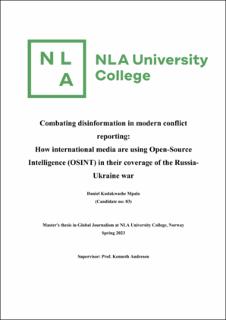| dc.description.abstract | This thesis examines how international media are using Open-Source Intelligence (OSINT) in their coverage of the Russia-Ukraine war. A mixed-methods approach employed conceptual content analysis, and textual analysis to a sample of AP News, BBC News, and Reuters coverage published between 24 February 2022 and 31 December 2022. The results showed that only 38.2% of coverage contained some form of OSINT analysis. In instances where OSINT content was used, the common types of OSINT material analysed included maps, satellite imagery, and visual footage. The most common methods of presenting the analysis included maps, text and images. While the media collaborated with external partners on 47.8% of the analysis, about a quarter was handled in-house, with 26.5% of the analysis sourced externally. The Institute for the Study of War, Maxar Technologies and Planet Labs emerged as the top sources of OSINT analysis, respectively. | en_US |
